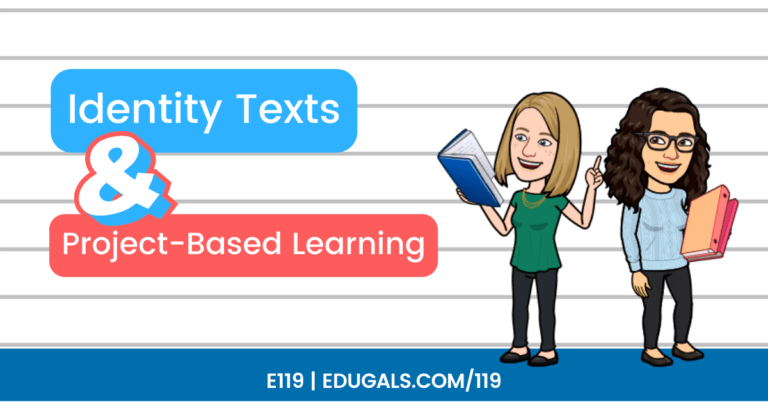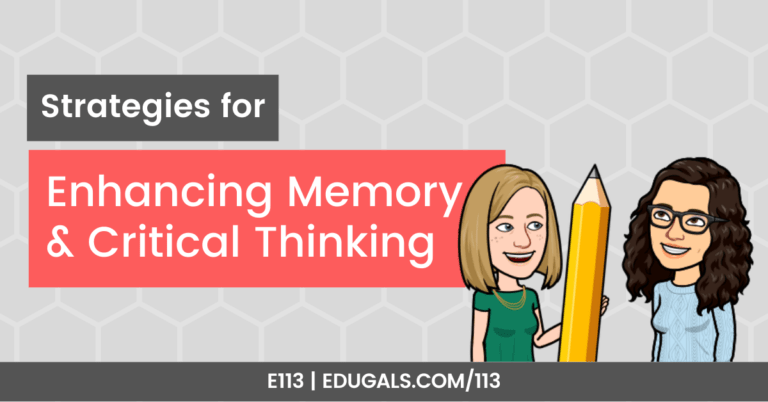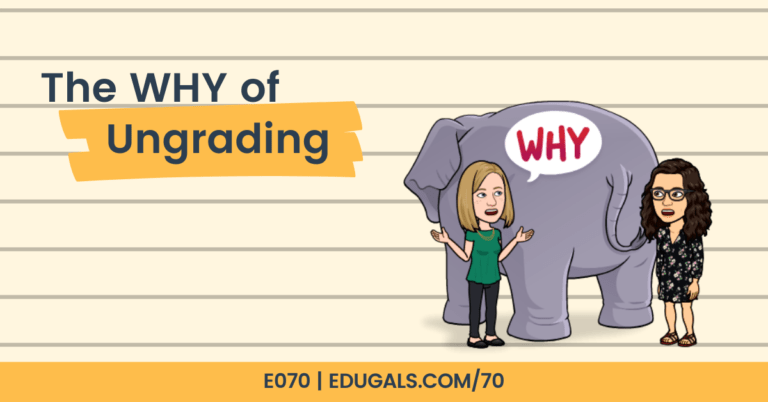[podcast_subscribe id=”7428″]
In this episode, we are talking all about Assessment and Evaluation in a quadmester and/or hybrid format. We will discuss a variety of ideas and tools that can be used in this very different school year.
If you like what you hear, we would love it if you could share this episode with a colleague or friend. And make sure you subscribe so that you don’t miss out on any new content!
We would love to hear from you – leave a comment here, OR check out our FLIPGRID!
Show Notes
Assessment and evaluation are such difficult areas in teaching right now. With a mix of in-class and virtual students, many educators are worried about the integrity of their course, but are also realizing that this is not a typical year, and that we need to plan differently.
There is certainly still a need for knowledge, but we also need to rethink the way that we ask our students to demonstrate their learning. If we give a question that can easily be Googled, then how are we really getting our students to demonstrate their learning?
Quizzes as Assessment & Evaluation
Quizzes can definitely still be a part assessment and evaluation in this strange new world of teaching. It’s just about how we build and approach quizzing.
Quizzes in Brightspace

In our Board, we have been mandated to use Brightspace as our LMS. One great feature of Brightspace is the use of the Quizzes tool.
Within the Quizzes tool in Brightspace, you can use multiple question pools in one quiz. You can create separate pools based on the number of marks a question is worth, based on the type of question you are having them complete, and more.
Another tip to consider: allow your students unlimited attempts of a quiz within a specific time period. It reduces cheating as well as the pressure to cheat, because students know that they can attempt it multiple times. In this scenario, one single completion doesn’t dictate their actual grade. Instead they can go back to their notes and practice the questions that they found difficult, and go back and attempt it again once they feel more comfortable and confident. With the use of question pools, each attempt will have slightly different questions, so it isn’t just a memorization of the questions.
Google Forms currently lacks the feature of question pools – if you want to see this feature added, consider giving this feedback to Google!
Assignment Submissions
Don’t let the assignment process end with a single submission. Give feedback, and allow students to go back, correct, and then resubmit their work.
It took virtual learning and this pandemic for many educators (ourselves included) to realize that conferencing and feedback cycles are where the real learning and development is happening. As the students finally get more comfortable and see their improvement, their confidence increases.
Covid is really pushing all people – educators and students – out of their comfort zones. It’s really forcing us to rethink our practice, and how we can help our students to improve.
With the hybrid model, combined with the accelerated timing of quadmesters, the mastery-based approach is a method of teaching that keeps coming up in our conversations. It really does seem like an effective approach to teaching right now.
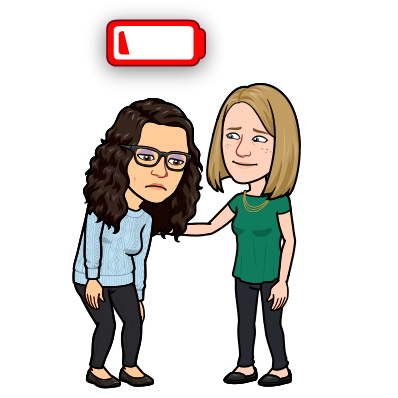
The challenges that we face as educators are really just the tip of the iceberg. We aren’t the only ones having a difficult time – our students are also struggling.
Please realize that some of our more vulnerable students are also having a hard time with the new format and accelerated pace of learning, and that they may not be ready to leave your classroom or program. Some of their actions may be them trying to fail, or trying to find a way to stay connected to your classroom as a safe space. In a year of uncertainty and discomfort, none of us are alone in our struggles.
Assessment and Evaluation Tools
There are a wide variety of tools that can be used for assessment and evaluation, particularly now in hybrid learning. One of the important things to keep in mind is that students should be comfortable with these tools prior to using them in a high stakes, or graded, situation.
Here are some assessment and evaluation tools that we think are worth checking out:
Quizzing Apps
There are a wide variety of quizzing apps and tools available to educators, such as Kahoot!, Quizizz, and more. Check out the various features to see which one works best for you!
EdPuzzle
EdPuzzle is great for flipped classrooms as well as non-flipped classrooms. You can put your own videos into EdPuzzle (and you can now share videos directly from Screencastify to EdPuzzle) and add questions, comments, audio notes, etc. throughout the video. EdPuzzle then gives you data that you can then track. And a great features of EdPuzzle is that students can’t fast forward through the video! Teachers are then left with data that informs them about how much students watched, what they struggled with, what should be retaught or reviewed, etc.
Nearpod
Nearpod is great, and it doesn’t require student logins. Similar to Pear Deck, you can add in quizzes, questions, collaborative boards, virtual field trips, and more! There is even an EdPuzzle-like tool where you can add videos with questions.
Pear Deck
Pear Deck is a great way to make slides interactive. Teachers can embed questions, check-ins, etc. throughout a lesson, allowing them to adapt or rephrase their lessons as needed. One of the down sides to this tool, however, is that it requires student logins. Our Board doesn’t allow us to use it for that reason.
Flipgrid
This video recording tool is fun to use, with lots of options built right in, including a digital white board. It can be a great way to get students to demonstrate their learning, and it also happens to be fun for students too.
Screencastify
This may sound super surprising to all of our listeners, however we think that this is an amazing tool for students and teachers. Not necessarily good for saving time, but this tool allows students to explain their learning, using their own words.
Both Flipgrid and Screencastify do offer data collection in terms of being able to reflect on skill progression from beginning of course to the end; Also, can have them record solutions and crowd source onto slides as a review tool
Thinking & Application-based Tasks
Interviews
Interviews are a great way to check for learning. As an educator, you can also customize or adapt your interview questions based on each individual student. This format is a much better way to learn what your students know, what they don’t and next steps for both you, as the educator, and them, as the student.
Portfolios
We have actually spoken about portfolios as assessment and/or evaluation in a previous episode (check that out here), but it’s worth mentioning again. Portfolios are great for demonstrating progression of learning. It’s also a great way to get students to reflect on their learning process and experiences, and to see their own growth over the course of the quadmester or semester.
There are a wide variety of tools that can be used for portfolios. Google Docs or Slides tend to be a fairly natural and comfortable tool for both educators and students, but you don’t have to stop there. Most LMS programs typically have a built-in portfolio feature. It’s worth looking into!
Additional options include: Google Sites, Wakelet, Blog, Video blog, and more!
As you brainstorm portfolios or projects, be sure to give students voice/choice. Structure it well so that it isn’t something that can simply be googled to find answers. And be sure to come up with purposeful objectives, clear success criteria, and allow students to choose their own path to get to the end result.
Debates & Small Groups

Small group activities are great for collaboration! These smaller group tasks give students a common goal – they can work together and share their ideas, learning, etc. to help support each other. It can be really difficult for students to learn and understand that they don’t have to do it all on their own. Teaching our students to do this in high school is important for their futures, as they learn how to share ideas with others, an important skill in most workplaces.
One example of small group activities are book or literature circles. In ESL, we offer different novel choices, and the students get to choose which one they want to read. They then get to work together with other students that have chosen that same novel. It is always amazing to watch as students learn to navigate this new relationship and group setting.
Another great idea is the use of debates. These are great for courses with controversial topics. For example, in biology, controversial topics include cloning, genetically modified foods, etc.
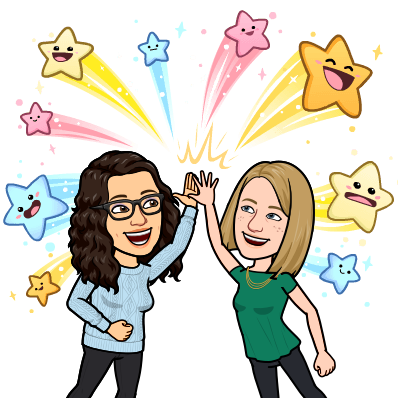
Whatever you choose to do with assessment and evaluation, be sure to incorporate choice. Let students have a bit of control, and allow them to play to their strengths.
Remember that you don’t need to reinvent everything right now! Pick one or two smaller things or topics, and slowly make changes and add to your courses. It’s really difficult to make these changes without knowing your students, so be sure to incorporate community building activities throughout your courses. As you get to know your students, the curriculum and its delivery all naturally fall into place, and assessment and evaluation strategies will too.
News & Updates
Google Meet Backgrounds
Way more options – not just the blurred option! You can now replace your background with a variety of different options, and no green screen is required! This is great for privacy and comfort levels. Check out the update here.
Flipped Learning with John Bergmann and Global GEG
John Bergmann spoke all about flipped learning, with a lot of really powerful messages for educators – check it out here!


